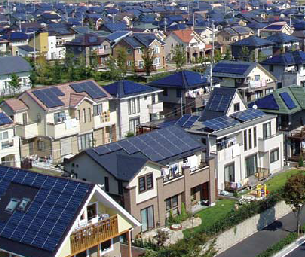J.M.Pearce (talk | contribs) m (Created page with "{{MOST}} ==Source== H.T. Nguyen and J.M. Pearce, “[http://hdl.handle.net/2297/33112 Automated Quantification of Solar Photovoltaic Potential in Cities]” ''International Rev...") |
J.M.Pearce (talk | contribs) m (→See Also) |
||
| (4 intermediate revisions by the same user not shown) | |||
| Line 2: | Line 2: | ||
==Source== | ==Source== | ||
H.T. Nguyen and J.M. Pearce, “[http://hdl.handle.net/2297/33112 Automated Quantification of Solar Photovoltaic Potential in Cities]” ''International Review for Spatial Planning and Sustainable Development'' '''1'''(1),(2013). 57-70. Open access | H.T. Nguyen and J.M. Pearce, “[http://hdl.handle.net/2297/33112 Automated Quantification of Solar Photovoltaic Potential in Cities]” ''International Review for Spatial Planning and Sustainable Development'' '''1'''(1),(2013). 57-70. [http://www.academia.edu/2370076/Automated_Quantification_of_Solar_Photovoltaic_Potential_in_Cities Open access] | ||
==Abstract== | ==Abstract== | ||
| Line 14: | Line 14: | ||
==See Also== | ==See Also== | ||
* | * [[Using LiDAR to assess rooftop solar photovoltaic potential on a large scale]] | ||
* | * [[Shading losses in solar photovoltaic potential at the municipal scale]] | ||
* | * [[Estimating the rooftop PV potential of a large-scale geographical region]] | ||
* [[An open source simulation of photovoltaic yield with r.sun over large regions]] | |||
* [[Power and energy potential of mass-scale photovoltaic noise barrier deployment- A case study for the U.S.]] | |||
* [[Technical Solar Photovoltaic Potential of Scaled Parking Lot Canopies- A Case Study of Walmart U.S.A.]] | |||
{{Solar navbox}} | |||
[[category: GIS]] | [[category: GIS]] | ||
Revision as of 19:33, 19 June 2017
Source
H.T. Nguyen and J.M. Pearce, “Automated Quantification of Solar Photovoltaic Potential in Cities” International Review for Spatial Planning and Sustainable Development 1(1),(2013). 57-70. Open access
Abstract

Solar photovoltaic (PV) energy conversion offers a sustainable method of producing electricity to maintain and improve the standard of living within cities. Planning for large-scale adoption of PV in cities, however, provides a challenge to urban planners because of the distributed nature of PV. This paper develops a new methodology to determine a city's PV potential by analysis of solar PV generation potential by distribution feeder given the solar exposure and orientation of rooftops serviced by a specific feeder within the city. The methodology is applied to an example feeder, and then can be scaled to apply to the network of any city. The method comprises the following steps:
- rooftop extraction from aerial photos;
- service parcel and territory matching based on geographical information system (GIS) data;
- simulation of the solar exposure of the customers connected to distribution feeders based on local meteorological conditions and the general roof orientation of the customers serviced by the feeder; and
- sensitivity analyses of electricity yield as a function of PV module efficiency.
Experience from the case study such as trade-offs between time consumption and data quality is discussed to highlight a need for connectivity between demographic information, electrical engineering schematics and GIS. Finally conclusions are developed to provide final methodology with the most and useful information from the highest constrained sources and can be adapted anywhere in the world.
See Also
- Using LiDAR to assess rooftop solar photovoltaic potential on a large scale
- Shading losses in solar photovoltaic potential at the municipal scale
- Estimating the rooftop PV potential of a large-scale geographical region
- An open source simulation of photovoltaic yield with r.sun over large regions
- Power and energy potential of mass-scale photovoltaic noise barrier deployment- A case study for the U.S.
- Technical Solar Photovoltaic Potential of Scaled Parking Lot Canopies- A Case Study of Walmart U.S.A.

